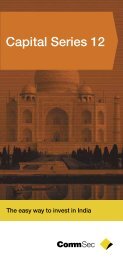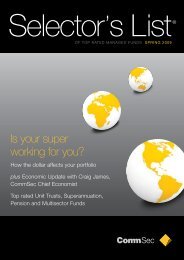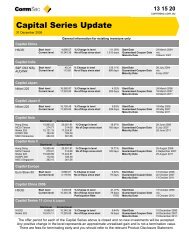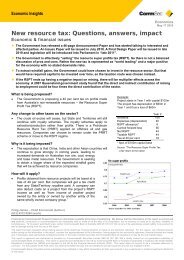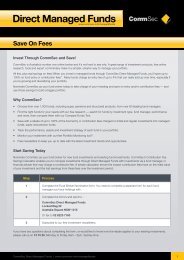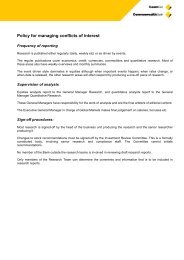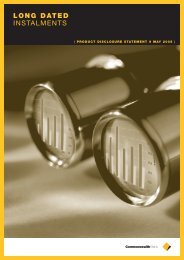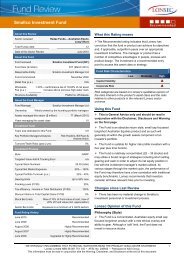US ExchangE- TradEd OpTiOnS prOdUcT diSclOSUrE ... - CommSec
US ExchangE- TradEd OpTiOnS prOdUcT diSclOSUrE ... - CommSec
US ExchangE- TradEd OpTiOnS prOdUcT diSclOSUrE ... - CommSec
You also want an ePaper? Increase the reach of your titles
YUMPU automatically turns print PDFs into web optimized ePapers that Google loves.
pag e 4<br />
U S e xc h a n g e -t r a d e d o p t i o n s<br />
The risks of trading <strong>US</strong> Options<br />
Trading in Options is typically viewed as a risky investment, suitable for experienced<br />
investors who have a high tolerance for risk. Before you apply for an Options account, you<br />
are required to read the Risk Disclosure Statement on page 36 of this PDS.<br />
Significant risks<br />
Here are the significant risks of trading <strong>US</strong> Options with <strong>CommSec</strong>.<br />
Limited life<br />
Volatility<br />
Leverage<br />
Taking Options<br />
Writing Options<br />
Difficulty closing<br />
positions<br />
Adjustments<br />
Options have a fixed expiry date, after which they are<br />
worthless. Their value can fall rapidly as they approach expiry.<br />
Because Options are highly leveraged, they are highly<br />
sensitive to changes in the value of the underlying security.<br />
While leverage can multiply your profits when you invest<br />
successfully, it can also multiply your losses when your view<br />
of the market proves incorrect.<br />
When you take an Option, the maximum amount you can<br />
lose is the premium you pay plus any transaction costs,<br />
such as brokerage.<br />
When you write a covered Call Option, you run the risk of<br />
being required to sell your shares at less than the current<br />
market price if the share price rises above the exercise<br />
price of the Option. If the share price falls, you risk making<br />
a loss on your investment in the underlying shares.<br />
When the market moves against you, you may find it<br />
difficult to close an open Option position if there is a<br />
significant change in its price over a short period of time.<br />
If the underlying share for an ETO makes a pro-rata change<br />
to its ordinary share capital structure the exchange may<br />
make adjustments to the specifications of the ETO to<br />
preserve their total exercisable value. That means that the<br />
result of the number of contracts multiplied by the contract<br />
size and multiplied by the exercise price is kept as the same<br />
total exercise dollar amount before and after the underlying<br />
security’s ex-date. Changes can be made to contract size,<br />
exercise price, expiry date, number of contracts, and even<br />
the underlying securities. As such changes can immediately<br />
affect important factors such as whether your ETO is<br />
‘in’ or ‘out’ of the money, you will need to review all ETO<br />
adjustments to ensure that the position still falls within your<br />
investment strategy (See “Corporate Actions” on page 14 for<br />
further information).



